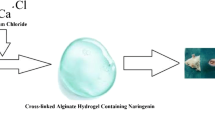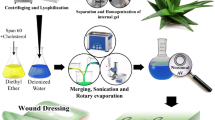Abstract
Daphne mucronata (DM) has regenerative features. Alginate hydrogel (Alg), as a natural scaffold, acts as a drug delivery system. This study aimed to assess the probable regenerative effects of DM encapsulated in Alg dermal scaffold on skin wound healing. Seventy-two male mice were grouped as: control (normal skin with no experimental treatments), sham (only punched skin), margarine (only margarine ointment administration), Alg group (Alg hydrogel with no DM), margarine-DM (margarine-based ointment with DM), and Alg-DM (DM encapsulated in Alg scaffold). DPPH assay was applied for phytochemical screening of DM. Cranial and cranial incisions of back were conducted for histological and gene expression evaluations, respectively. Alg scaffold was placed on wound and supported by a dressing pad. Tissue sampling was applied on 3, 7, 12, and 22 days of treatments. Collagen deposition, regeneration rate, angiogenesis and granulation, respectively, were assessed through hydroxyproline assay, caliper instrument, CD31 immunohistochemistry staining, and ImageJ software. Also, gene expression of MMP13, EGF, and bFGF was evaluated by real-time PCR. Data were analyzed using SPSS (V. 16), and graphs were drawn by GraphPad Prism (V.9, 2020) software. Antioxidant agents of DM were approved by the DPPH assay. Besides, it was found that DM restored the damaged dermal tissue and increased the expression of genes involved in wound healing significantly (p < 0.05) in 7 and 12 days of experiment in both groups of margarine-DM and Alg-DM than control. Application of hydroalcoholic extract of DM encapsulated in alginate hydrogel scaffold can accelerate skin tissue regeneration by induction of genes expression and histological tissue indices in dermal injuries.
It is believed that the drug delivery system can increase the effectiveness of a drug. Application of dermal scaffold leads to the early expression of genes involved in wound healing and changes of histopathological factors. This study found that the Daphne mucronata extract encapsulated in alginate gel can accelerate wound healing by modulation of the expression of genes and tissue factors. This technique can be used in other pathologic skin-related conditions like diabetes or other non-skin injuries like musculoskeletal disorders.





Similar content being viewed by others
References
Ahn K. The worldwide trend of using botanical drugs and strategies for developing global drugs. J Biochem Mol Biol. 2017;50(3):111.
Ekor M. The growing use of herbal medicines: issues relating to adverse reactions and challenges in monitoring safety. Front Pharmacol. 2013;4:177.
Khodadadian Z, Hassanpour-Ezatti M, Mousavi SZ, Asgarpanah J. Analgesic and anti-inflammatory potential of aerial parts of the Daphne mucronata Royle extract in mice: Opioid-independent action. Asian Pac J Trop Biomed. 2016;6(3):198–201.
Fazal N, Khawaja H, Naseer N, Khan AJ, Latief N. Daphne mucronata enhances cell proliferation and protects human adipose stem cells against monosodium iodoacetate induced oxidative stress in vitro. Adipocyte. 2020;9(1):495–508.
Zarrintaj P, Moghaddam AS, Manouchehri S, Atoufi Z, Amiri A, Amirkhani MA, Nilforoushzadeh MA, Saeb MR, Hamblin MR, Mozafari M. Can regenerative medicine and nanotechnology combine to heal wounds? The search for the ideal wound dressing. Nanomedicine. 2017;12(19):2403–22.
Eaglstein WH. Moist wound healing with occlusive dressings: a clinical focus. Dermatol Surg. 2001;27(2):175–82.
Selvaraj D, Viswanadha VP, Elango S. Wound dressings-a review. Biomedicine. 2015;5:22.
Davies JC. Pseudomonas aeruginosa in cystic fibrosis: pathogenesis and persistence. Paediatr Respir Rev. 2002;3(2):128–34.
Lansdown AB. Calcium: a potential central regulator in wound healing in the skin. Wound Repair and Regeneration. 2002;10(5):271–85.
Stubbe B, Mignon A, Declercq H, Van Vlierberghe S, Dubruel P. Development of Gelatin-Alginate Hydrogels for Burn Wound Treatment. Macromol Biosci. 2019;19(8):1900123.
Nguyen D, Orgill D, Murphy G. The pathophysiologic basis for wound healing and cutaneous regeneration. Biomaterials for Treating Skin Loss. 2009;25–57.
Stadelmann WK, Digenis AG, Tobin GR. Physiology and healing dynamics of chronic cutaneous wounds. Am J Surg. 1998;176(2):26–38.
Enoch S, Price P. Cellular, molecular and biochemical differences in the pathophysiology of healing between acute wounds, chronic wounds and wounds in the aged. World Wide Wounds. 2004;13:1–17.
Mirdailami O, Soleimani M, Dinarvand R, Khoshayand MR, Norouzi M, Hajarizadeh A, Dodel M, Atyabi F. Controlled release of rh EGF and rhb FGF from electrospun scaffolds for skin regeneration. J Biomed Mater Res. 2015;103(10):3374–85.
Hattori N, Mochizuki S, Kishi K, Nakajima T, Takaishi H, D’Armiento J, Okada Y. MMP-13 plays a role in keratinocyte migration, angiogenesis, and contraction in mouse skin wound healing. Am J Pathol. 2009;175(2):533–46.
Yang Y, Xia T, Zhi W, Wei L, Weng J, Zhang C, Li X. Promotion of skin regeneration in diabetic rats by electrospun core-sheath fibers loaded with basic fibroblast growth factor. Biomaterials. 2011;32(18):4243–54.
Yadav R, Agarwala M. Phytochemical analysis of some medicinal plants. Journal of Phytological Research. 2011.
Kulisic T, Radonic A, Katalinic V, Milos M. Use of different methods for testing antioxidative activity of oregano essential oil. Food Chem. 2004;85(4):633–40.
Shimada K, Fujikawa K, Yahara K, Nakamura T. Antioxidative properties of xanthan on the autoxidation of soybean oil in cyclodextrin emulsion. J Agric Food Chem. 1992;40(6):945–8.
Afshar M, Zardast M, Vahdati F. Effects of azulene on granulation tissue formation and epithelialization during skin wound healing in BALB/c mice. J Mazandaran Univ Med Sci. 2019;28(170):1–10.
Zhang X, Li Y, Ma Z, He D, Li H. Modulating degradation of sodium alginate/bioglass hydrogel for improving tissue infiltration and promoting wound healing. Bioactive Mater. 2021;6(11):3692–704.
Cissell DD, Link JM, Hu JC, Athanasiou KA. A modified hydroxyproline assay based on hydrochloric acid in Ehrlich’s solution accurately measures tissue collagen content. Tissue Eng Part C Methods. 2017;23(4):243–50.
Kilkenny C, Browne WJ, Cuthill IC, Emerson M, Altman DG. Improving Bioscience Research Reporting: The ARRIVE Guidelines for Reporting Animal Research. PLOS Biology. 2010;8(6):e1000412.
Baloch AH, Baloch IA, Ahmed I, Ahmed S. A study of poisonous plants of Balochistan, Pakistan. Pure and Applied Biology (PAB). 2017;6(3):989–1001.
Boontheekul T, Kong HJ, Mooney DJ. Controlling alginate gel degradation utilizing partial oxidation and bimodal molecular weight distribution. Biomaterials. 2005;26(15):2455–65.
Jaya S, Durance TD, Wang R. Physical characterization of drug loaded microcapsules and controlled in vitro release study. Open Biomater J. 2010;2(1).
Moseley R, Hilton JR, Waddington RJ, Harding KG, Stephens P, Thomas DW. Comparison of oxidative stress biomarker profiles between acute and chronic wound environments. Wound Repair Regeneration. 2004;12(4):419–29.
Song Y, Zeng R, Hu L, Maffucci KG, Ren X, Qu Y. In vivo wound healing and in vitro antioxidant activities of Bletilla striata phenolic extracts. Biomed Pharmacother. 2017;93:451–61.
Natarajan V, Krithica N, Madhan B, Sehgal PK. Preparation and properties of tannic acid cross-linked collagen scaffold and its application in wound healing. J Biomed Mater Res. 2013;101(4):560–7.
Taguchi N, Yuriguchi M, Ando T, Kitai R, Aoki H, Kunisada T. Flavonoids with Two OH Groups in the B-Ring Promote Pigmented Hair Regeneration. Biol Pharm Bull. 2019;42(9):1446–9.
Zyuz’kov GN, Krapivin AV, Nesterova YV, Povetieva TN, Zhdanov VV, Suslov NI, Fomina TI, Udut EV, Miroshnichenko LA, Simanina EV, Semenov AA. Mechanisms of regeneratory effects of baikal aconite diterpene alkaloids. Bull Experiment Biol Med. 2012;153(6):847–51.
Kimura Y, Sumiyoshi M, Kawahira K, Sakanaka M. Effects of ginseng saponins isolated from Red Ginseng roots on burn wound healing in mice. Br J Pharmacol. 2006;148(6):860–70.
Regalado EL, Rodríguez M, Menéndez R, Concepción ÁA, Nogueiras C, Laguna A, Rodríguez AA, Williams DE, Lorenzo-Luaces P, Valdés O, Hernandez Y. Repair of UVB-damaged skin by the antioxidant sulphated flavone glycoside thalassiolin B isolated from the marine plant Thalassia testudinum Banks ex König. Mar Biotechnol. 2009;11(1):74.
Addor FASa. Antioxidants in dermatology. J Brazilian Ann Dermatol. 2017;92(3):356–62.
Yohn JJ, Norris DA, Yrastorza DG, Buno IJ, Leff JA, Hake SS, Repine JE. Disparate antioxidant enzyme activities in cultured human cutaneous fibroblasts, keratinocytes, and melanocytes. J Investig Dermatol. 1991;97(3):405–9.
Chen Y, Miao Y, Huang L, Li J, Sun H, Zhao Y, Yang J, Zhou W. Antioxidant activities of saponins extracted from Radix Trichosanthis: an in vivo and in vitro evaluation. BMC Complementary Medicine and Therapies. 2014;14(1):86.
Morisaki N, Watanabe S, Tezuka M, Zenibayashi M, Shüna R, Koyama N, Kanzaki T, Saito Y. Mechanism of angiogenic effects of saponin from ginseng Radix rubra in human umbilical vein endothelial cells. Br J Pharmacol. 1995;115(7):1188–93.
DiPietro LA. Angiogenesis and wound repair: when enough is enough. J Leukoc Biol. 2016;100(5):979–84.
Alhajj M, Bansal P, Goyal A. Physiology. Granulation Tissue: StatPearls Publishing; 2020.
Kwon SH, Park KC. Antioxidants as an Epidermal Stem Cell Activator. Antioxidants. 2004;9(10):958.
Mariia K, Arif M, Shi J, Song F, Chi Z, Liu C. Novel chitosan-ulvan hydrogel reinforcement by cellulose nanocrystals with epidermal growth factor for enhanced wound healing: In vitro and in vivo analysis. Int J Biol Macromol. 2021;183:435–46.
Funding
This work was supported by grant No.97151 by Deputy of Research of KUMS, Kermanshah, Iran.
Author information
Authors and Affiliations
Contributions
This study was designed by MR. Gh. as a corresponding author. S. A. K. as leader of research group managed the experimental protocols. A. S., S. N., and M. A. were involved in practical laboratory procedures. The manuscript was prepared by A. A. and confirmed by all authors.
Corresponding author
Ethics declarations
Conflict of Interest
The authors declare they have no conflict of interest.
Additional information
Publisher's Note
Springer Nature remains neutral with regard to jurisdictional claims in published maps and institutional affiliations.
Rights and permissions
About this article
Cite this article
Karimi, S.A., Abdolmaleki, A., Sadeghi, A. et al. Drug Delivery System Through Alginate Dermal Scaffold Loaded with Hydroalcoholic Extract of Daphne Mucronata Improves Dermal Excisional Wound Healing: An Experimental Research. Regen. Eng. Transl. Med. 8, 523–534 (2022). https://doi.org/10.1007/s40883-022-00252-3
Received:
Revised:
Accepted:
Published:
Issue Date:
DOI: https://doi.org/10.1007/s40883-022-00252-3




